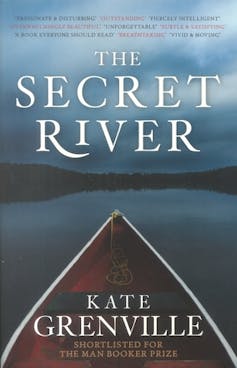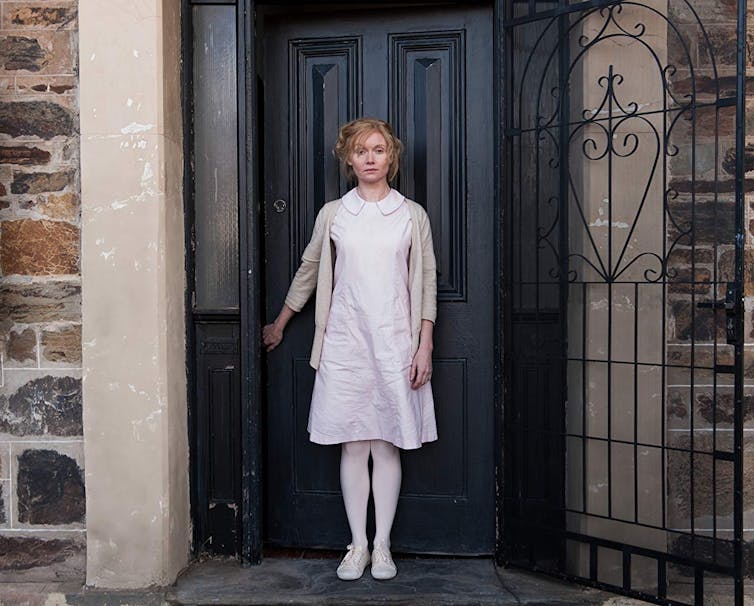from Hanging Rock to Nick Cave and Kylie, this genre explores our dark side
- Written by Emma Doolan, Lecturer in Creative Writing, Southern Cross University
In the popular imagination, the term “Gothic” evokes images of grim, crumbling castles, wild moors, jagged mountain peaks, and coffins creaking open in labyrinthine underground crypts.
Populating this Gothic terrain are bloodsucking (or, more recently, sparkling) vampires, howling werewolves, ghostly apparitions, black-browed villains, and virginal maidens (usually with great hair) fleeing persecution and imprisonment.
Gothic novels, films, and other texts explore the terrors of the unseen, or the half-seen – the repressed matter that threatens to return. Its plots turn on uncertainty and anxiety, sexual danger and desire, inheritance and usurpation, and boundaries and their transgression.
Read more: Friday essay: the female werewolf and her shaggy suffragette sisters
Early Gothic novels, arguably beginning with Horace Walpole’s The Castle of Otranto in 1764, were the bestsellers of their day.
Ann Radcliffe’s literary hits, such as The Mysteries of Udolpho (1794), were so popular, particularly among young female readers, that Jane Austen satirised the period’s Gothic craze in Northanger Abbey (1817).
 Goodreads
The Gothic lives on today in a variety of forms, from books like Stephanie Meyer’s Twilight to binge-worthy television shows like The Haunting of Hill House.
An Australian tradition
For some early commentators, the idea of an Australian Gothic aesthetic was laughable. Australia, given its lack of European history or ivy-covered ruins, couldn’t hope to lay “the foundations of a second ‘Castle of Otranto’”, wrote journalist Frederick Sinnett in 1856.
But consider these examples: Albert Tucker’s 1956 painting Apocalyptic Horse; Kenneth Cook’s 1961 novel Wake in Fright; Joan Lindsay’s Picnic at Hanging Rock and its adaptations; and George Miller’s Mad Max films.
Or what about Nick Cave and Kylie Minogue’s Where the Wild Roses Grow?
These works all belong to an Australian Gothic tradition that took root alongside colonisation.
Nick Cave and Kylie Minogue - Where the Wild Roses Grow.
Read more:
How Gothic buildings became associated with Halloween and the supernatural
The Gothic genre gave early Australian writers and artists a way to explore the dark side of the Australian experience. This included the perceived hostility of the natural environment, the violence of colonisation, convicts’ experiences of exile and entrapment, settlers’ feelings of alienation, and European fears of the racial Other.
In Marcus Clarke’s For the Term of His Natural Life (1874), Henry Lawson’s The Bush Undertaker (1892), and Barbara Baynton’s Bush Studies (1902), Australia is not a country of promise and plenty, but rather a menacing and claustrophobic hell. The iconic swagman becomes a monstrous figure, the bush is haunted by a “weird melancholy”, and the landscape imprisons and threatens.
Contemporary Australian Gothic
Anxieties about Australia’s colonial past have also been explored more recently in Gothic literature and film. Kate Grenville’s The Secret River (2005) returns to the Gothic bush to confront the guilty legacy of colonisation. The novel traces convict William Thornhill’s determination to possess a land plot along the Hawkesbury River, and the desire, fear, and greed that lead him to participate in the massacre of its Aboriginal owners.
Goodreads
The Gothic lives on today in a variety of forms, from books like Stephanie Meyer’s Twilight to binge-worthy television shows like The Haunting of Hill House.
An Australian tradition
For some early commentators, the idea of an Australian Gothic aesthetic was laughable. Australia, given its lack of European history or ivy-covered ruins, couldn’t hope to lay “the foundations of a second ‘Castle of Otranto’”, wrote journalist Frederick Sinnett in 1856.
But consider these examples: Albert Tucker’s 1956 painting Apocalyptic Horse; Kenneth Cook’s 1961 novel Wake in Fright; Joan Lindsay’s Picnic at Hanging Rock and its adaptations; and George Miller’s Mad Max films.
Or what about Nick Cave and Kylie Minogue’s Where the Wild Roses Grow?
These works all belong to an Australian Gothic tradition that took root alongside colonisation.
Nick Cave and Kylie Minogue - Where the Wild Roses Grow.
Read more:
How Gothic buildings became associated with Halloween and the supernatural
The Gothic genre gave early Australian writers and artists a way to explore the dark side of the Australian experience. This included the perceived hostility of the natural environment, the violence of colonisation, convicts’ experiences of exile and entrapment, settlers’ feelings of alienation, and European fears of the racial Other.
In Marcus Clarke’s For the Term of His Natural Life (1874), Henry Lawson’s The Bush Undertaker (1892), and Barbara Baynton’s Bush Studies (1902), Australia is not a country of promise and plenty, but rather a menacing and claustrophobic hell. The iconic swagman becomes a monstrous figure, the bush is haunted by a “weird melancholy”, and the landscape imprisons and threatens.
Contemporary Australian Gothic
Anxieties about Australia’s colonial past have also been explored more recently in Gothic literature and film. Kate Grenville’s The Secret River (2005) returns to the Gothic bush to confront the guilty legacy of colonisation. The novel traces convict William Thornhill’s determination to possess a land plot along the Hawkesbury River, and the desire, fear, and greed that lead him to participate in the massacre of its Aboriginal owners.
 Goodreads
Indigenous writers such as Alexis Wright and Kim Scott have also appropriated the Gothic, overturning tropes that cast Indigenous people as the monstrous Other and instead positioning colonisers as terrifying figures.
The subgenre Tasmanian Gothic (see Richard Flanagan and Rohan Wilson), meanwhile, often reveals anxieties about the colonial genocide of Aboriginal people, and present-day environmental degradation. For example, the extinct Tasmanian Tiger haunts Tasmania’s landscape in the 2011 Daniel Nettheim film The Hunter, based on the 1999 novel by Julia Leigh.
Australian Gothic increasingly finds new sites to play out its terrors. In Jennifer Kent’s 2014 film The Babadook, the Gothic moves into the urban, domestic space of an Adelaide terrace house where a mother and child are terrorised when the horrifying “Babadook” emerges from a child’s pop-up book.
The film has been read as an exploration of grief and the terrors of childhood and parenting, demonstrating Australian Gothic’s ability to tackle diverse topics.
Goodreads
Indigenous writers such as Alexis Wright and Kim Scott have also appropriated the Gothic, overturning tropes that cast Indigenous people as the monstrous Other and instead positioning colonisers as terrifying figures.
The subgenre Tasmanian Gothic (see Richard Flanagan and Rohan Wilson), meanwhile, often reveals anxieties about the colonial genocide of Aboriginal people, and present-day environmental degradation. For example, the extinct Tasmanian Tiger haunts Tasmania’s landscape in the 2011 Daniel Nettheim film The Hunter, based on the 1999 novel by Julia Leigh.
Australian Gothic increasingly finds new sites to play out its terrors. In Jennifer Kent’s 2014 film The Babadook, the Gothic moves into the urban, domestic space of an Adelaide terrace house where a mother and child are terrorised when the horrifying “Babadook” emerges from a child’s pop-up book.
The film has been read as an exploration of grief and the terrors of childhood and parenting, demonstrating Australian Gothic’s ability to tackle diverse topics.
 Essie Davis in The Babadook, a film which explores gothic themes in suburbia.
Screen Australia/IMDB
Read more:
Friday essay: why YA gothic fiction is booming - and girl monsters are on the rise
Tropical and subtropical Australia have also been portrayed as “Gothic” in the novels of Janette Turner Hospital and Thea Astley, and in the recent Netflix series Tidelands, in which supernatural sirens inhabit the waters off the Queensland coast.
As literary scholars David Punter and Glennis Byron have pointed out, the Gothic genre flourishes at times of upheaval. It allows us to share fears, subvert norms, and point towards what might be overlooked in our history and culture.
Gothic will remain a popular mode for Australian writers, filmmakers, and other artists as long as anxieties about the colonial past, race, gender, and difference remain with us.
Essie Davis in The Babadook, a film which explores gothic themes in suburbia.
Screen Australia/IMDB
Read more:
Friday essay: why YA gothic fiction is booming - and girl monsters are on the rise
Tropical and subtropical Australia have also been portrayed as “Gothic” in the novels of Janette Turner Hospital and Thea Astley, and in the recent Netflix series Tidelands, in which supernatural sirens inhabit the waters off the Queensland coast.
As literary scholars David Punter and Glennis Byron have pointed out, the Gothic genre flourishes at times of upheaval. It allows us to share fears, subvert norms, and point towards what might be overlooked in our history and culture.
Gothic will remain a popular mode for Australian writers, filmmakers, and other artists as long as anxieties about the colonial past, race, gender, and difference remain with us.
Authors: Emma Doolan, Lecturer in Creative Writing, Southern Cross University



